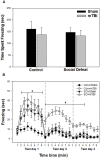Mild Traumatic Brain Injury with Social Defeat Stress Alters Anxiety, Contextual Fear Extinction, and Limbic Monoamines in Adult Rats
- PMID: 27147992
- PMCID: PMC4835499
- DOI: 10.3389/fnbeh.2016.00071
Mild Traumatic Brain Injury with Social Defeat Stress Alters Anxiety, Contextual Fear Extinction, and Limbic Monoamines in Adult Rats
Abstract
Mild traumatic brain injury (mTBI) produces symptoms similar to those typifying posttraumatic stress disorder (PTSD) in humans. We sought to determine whether a rodent model of stress concurrent with mTBI produces characteristics of PTSD such as impaired contextual fear extinction, while also examining concurrent alterations to limbic monoamine activity in brain regions relevant to fear and anxiety states. Male rats were exposed to social stress or control conditions immediately prior to mTBI induction, and 6 days later were tested either for anxiety-like behavior using the elevated plus maze (EPM), or for contextual fear conditioning and extinction. Brains were collected 24 h after EPM testing, and tissue from various limbic regions analyzed for content of monoamines, their precursors and metabolites using HPLC with electrochemical detection. Either social defeat or mTBI alone decreased time spent in open arms of the EPM, indicating greater anxiety-like behavior. However, this effect was enhanced by the combination of treatments. Further, rats exposed to both social defeat and mTBI exhibited greater freezing within extinction sessions compared to all other groups, suggesting impaired contextual fear extinction. Social defeat combined with mTBI also had greater effects on limbic monoamines than either insult alone, particularly with respect to serotonergic effects associated with anxiety and fear learning. The results suggest social stress concurrent with mTBI produces provides a relevant animal model for studying the prevention and treatment of post-concussive psychobiological outcomes.
Keywords: anxiety; fear conditioning; mild traumatic brain injury; monoamine; posttraumatic stress disorder; social stress.
Figures





Similar articles
-
Mild traumatic brain injury in the rat alters neuronal number in the limbic system and increases conditioned fear and anxiety-like behaviors.Exp Neurol. 2012 Jun;235(2):574-87. doi: 10.1016/j.expneurol.2012.03.012. Epub 2012 Apr 1. Exp Neurol. 2012. PMID: 22498103
-
Sex differences in the effects of mild traumatic brain injury and progesterone treatment on anxiety-like behavior and fear conditioning in rats.Exp Neurol. 2023 Jul;365:114415. doi: 10.1016/j.expneurol.2023.114415. Epub 2023 Apr 17. Exp Neurol. 2023. PMID: 37075970
-
Effects of mild TBI from repeated blast overpressure on the expression and extinction of conditioned fear in rats.Neuroscience. 2013 Dec 19;254:120-9. doi: 10.1016/j.neuroscience.2013.09.021. Epub 2013 Sep 19. Neuroscience. 2013. PMID: 24056195
-
Translational relevance of fear conditioning in rodent models of mild traumatic brain injury.Neurosci Biobehav Rev. 2021 Aug;127:365-376. doi: 10.1016/j.neubiorev.2021.04.037. Epub 2021 May 4. Neurosci Biobehav Rev. 2021. PMID: 33961927 Review.
-
The Melatonergic System in Anxiety Disorders and the Role of Melatonin in Conditional Fear.Vitam Horm. 2017;103:281-294. doi: 10.1016/bs.vh.2016.09.003. Epub 2016 Oct 31. Vitam Horm. 2017. PMID: 28061973 Review.
Cited by
-
Systemic Administration of Curcumin Affect Anxiety-Related Behaviors in a Rat Model of Posttraumatic Stress Disorder via Activation of Serotonergic Systems.Evid Based Complement Alternat Med. 2018 Jun 19;2018:9041309. doi: 10.1155/2018/9041309. eCollection 2018. Evid Based Complement Alternat Med. 2018. PMID: 30018659 Free PMC article.
-
Calcineurin signaling as a target for the treatment of alcohol abuse and neuroinflammatory disorders.Prog Mol Biol Transl Sci. 2019;167:125-142. doi: 10.1016/bs.pmbts.2019.06.008. Epub 2019 Aug 12. Prog Mol Biol Transl Sci. 2019. PMID: 31601401 Free PMC article. Review.
-
Fyn kinase inhibition reduces protein aggregation, increases synapse density and improves memory in transgenic and traumatic Tauopathy.Acta Neuropathol Commun. 2020 Jul 1;8(1):96. doi: 10.1186/s40478-020-00976-9. Acta Neuropathol Commun. 2020. PMID: 32611392 Free PMC article.
-
Carbamoylated erythropoietin modulates cognitive outcomes of social defeat and differentially regulates gene expression in the dorsal and ventral hippocampus.Transl Psychiatry. 2018 Jun 8;8(1):113. doi: 10.1038/s41398-018-0168-9. Transl Psychiatry. 2018. PMID: 29884778 Free PMC article.
-
The Neurobiological Links between Stress and Traumatic Brain Injury: A Review of Research to Date.Int J Mol Sci. 2022 Aug 23;23(17):9519. doi: 10.3390/ijms23179519. Int J Mol Sci. 2022. PMID: 36076917 Free PMC article. Review.
References
-
- Almeida-Suhett C. P., Prager E. M., Pidoplichko V., Figueiredo T. H., Marini A. M., Li Z., et al. (2014). Reduced GABAergic inhibition in the basolateral amygdala and the development of anxiety-like behaviors after mild traumatic brain injury. PLoS ONE 9:e102627 10.1371/journal.pone.0102627 - DOI - PMC - PubMed
-
- Barr J. L., Scholl J. L., Solanki R. R., Watt M. J., Lowry C. A., Renner K. J., et al. (2013). Influence of chronic amphetamine treatment and acute withdrawal on serotonin synthesis and clearance mechanisms in the rat ventral hippocampus. Eur. J. Neurosci. 37 479–490. 10.1111/ejn.12050 - DOI - PMC - PubMed
LinkOut - more resources
Full Text Sources
Other Literature Sources

